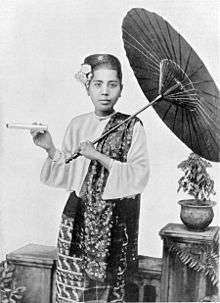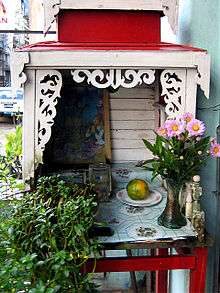Bamar people
.jpg) | |
| Total population | |
|---|---|
| c. 30,000,000 | |
| Regions with significant populations | |
| Burma, Thailand, Singapore, Malaysia, United States, United Kingdom, Australia | |
| 28,950,000 | |
| 1,000,000 | |
| 50,000 | |
| Languages | |
| Burmese | |
| Religion | |
|
Theravada Buddhism minority Islam and Christianity | |
| Related ethnic groups | |
| Rakhine, Marma, Chakma, Yi, Nakhi, Tibetans | |
The Bamar (Burmese: ဗမာလူမျိုး; MLCTS: ba. ma lu myui:; IPA: [bəmà lùmjó]) are the dominant ethnic group in Burma. Bamar people live primarily in the Irrawaddy River basin and speak the Burmese language, which is the official language of Burma. Bamar customs and identity are closely intertwined with the broader Burmese culture. The Bamar people are often imprecisely called "Burmese", though this term in contemporary usage can refer to any citizen of Burma, regardless of ethnicity.
Language
The Burmese language, the official language of Burma, is widely spoken by many of the ethnic minorities as well as the majority Bamar. Its core vocabulary consists of Sino-Tibetan words, but many terms associated with Buddhism, arts, sciences, and government have derived from the Indo-European languages of Pali and English. The Rakhine, although culturally distinct from the Bamar, are ethnically related to them and speak a dialect of Burmese that includes retention of the /r/ sound, which has coalesced into the /j/ sound in standard Burmese (although it is still present in orthography). Additional dialects come from coastal areas of Tanintharyi Region (including Myeik (Beik) and Dawei (Tavoyan)) as well as inland and isolated areas, like Yaw. Other dialects are Taungyoe, Danu, and Intha in Shan State.[1] English was introduced in the 1800s when the Bamar first came into contact with the British as a trading nation and continued to flourish under subsequent colonial rule.
Origins
The Bamar are of East Asian descent and speak a Sino-Tibetan language (related to Tibetan and more distantly to Chinese). They migrated from the north and China-India borderlands into the Irrawaddy River valley in Upper Burma about 1200–1500 years ago. Over the last millennium, they have largely replaced/absorbed the Austroasiatic-speaking Mon and the Sino-Tibetan-speaking people of the Pyu city-states, ethnic groups that formerly dominated the region.[2]
Distribution
The Bamar are most numerous in Burma, constituting the majority ethnic group. Many have settled in Europe, particularly in Great Britain. The Burmese diaspora, which is a recent phenomenon in historical terms and began at the start of World War II, has been mainly brought about by a protracted period of military rule and reflects the ethnic diversity of Burma.
Firstly, the Anglo-Burmese following Burmese independence in 1948 began moving to the United Kingdom, Australia, New Zealand and North America, to be followed by the Bamar themselves. It is by no means confined to the West; Malaysia, Singapore, Hong Kong, Taiwan, Australia, Korea and Japan are also popular destinations. Burmese settled in Australia, New Zealand and the UK tend to be overwhelmingly of Anglo-Burmese origins.
Culture and society

Bamar culture has been influenced by the cultures of neighbouring countries. This is manifested in its language, cuisine, music, dance and theatre. The arts, particularly literature, have historically been influenced by the local form of Theravada Buddhism. In a traditional village, the monastery is the centre of cultural life. Monks are venerated and supported by the lay people. Rites of passage are also of cultural importance to the Bamar. These include shinbyu (ရှင်ပြု), a novitiate ceremony for Buddhist boys, and nar tha (နားထွင်း), an ear-piercing ceremony for girls. Burmese culture is most evident in villages where local festivals are held throughout the year, the most important being the pagoda festival. Many villages have a guardian nat, and superstition and taboos are commonplace.
Traditional Dress
Bamar people traditionally wear sarongs, known in Burmese as longyi (လုံချည်). Women wear a type of sarong known as htamain (ထဘီ), while men wear a sarong sewn into a tube, called a longyi, or, more formally, a single long piece wrapped around the hips, known in Burmese as a paso (ပုဆိုး). Formal attire often consists of gold jewelry, silk scarves, and jackets. On formal occasions, men often wear cloth turbans called gaung baung (ခေါင်းပေါင်း) and Mandarin collared jackets called taikpon (တိုက်ပုံ), while women wear blouses.
Both genders wear velvet sandals called gadiba phanat (ကတ္တီပါဖိနပ်, also called Mandalay phanat), although leather, rubber and plastic sandals (ဂျပန်ဖိနပ်, lit. Japanese shoes) are also worn. In cities and urban areas, Western dress, including T-shirts, jeans and sports shoes or trainers, has become popular, especially among the younger generation. Talismanic tattoos, earrings, and long hair tied in a knot were once common among Bamar men, but have ceased to be fashionable since after World War II; men in shorts and sporting ponytails, as well as both sexes with bleached hair, have made their appearance in Yangon and Mandalay more recently, especially in the anything-goes atmosphere of the Burmese New Year holiday known as Thingyan.
Westernization mostly comes via Japan and Singapore. Bamar people of both sexes and all ages also wear thanaka, especially on their faces, although the practice is largely confined to women, children and young, unmarried men. Western makeup and cosmetics have long enjoyed a popularity in urban areas. However, thanaka is not exclusively worn by the Bamar, as many other ethnic groups throughout Burma utilize this cosmetic.
Bamar cuisine
Bamar cuisine contains many regional elements, such as stir frying techniques and curries which can be hot but lightly spiced otherwise, almost always with fish paste as well as onions, garlic, ginger, dried chilli and turmeric. Rice (ထမင်း htamin) is the staple, although noodles (ခေါက်ဆွဲ hkauk swè), salads (အသုတ် a thouk), and breads (ပေါင်မုန့် paung mont) are also eaten. Green tea is often the beverage of choice, but tea is also traditionally pickled and eaten as a salad called lahpet. The best-known dish of Bamar origin is mohinga, rice noodles in a fish broth. It is available in most parts of the region,also considered as the national dish of Myanmar. Dishes from other ethnic minorities (Shan, Chinese, Indian) are also consumed.
Bamar music
Traditional Bamar music consists of an orchestra mainly of percussion and wind instruments but the saung gauk (စောင်းကောက်), a boat-shaped harp, is often symbolic of the Bamar. Other traditional instruments include pattala (Burmese xylophone), walatkhok, lagwin, and hsaingwaing. Modern Bamar music is typically westernized, with influences particularly from American country music. However, rap and hip-hop have also gained popularity. Traditional Bamar dancing is similar to Thai dancing. Puppetry is also a popular form of entertainment and is often performed at pwés, which is a generic term for shows, celebrations and festivals. In urban areas, movies from both Bollywood and Hollywood have long been popular, but more recently Korean and Chinese films, especially DVDs, have become increasingly popular.
Festivals
Buddhist festivals and holidays are widely celebrated by the Bamar people. Thingyan, the Water Festival, which marks the beginning of the Burmese New Year in April, is one such example. Thadingyut, which marks the end of the Buddhist lent, is celebrated with the Festival of Lights in October. Kathina or robe offering ceremony for monks is held at the start of Lent in July and again in November.
Religion

The majority of the Bamar are Theravada Buddhists. People are expected to keep the basic Five Precepts and practise dāna "charity", śīla "morality" and vipassanā "meditation". Most villages have a monastery and often a stupa maintained and supported by the layfolk. Annual pagoda festivals usually fall on a full moon day, and robe offering ceremonies for monks are held both at the beginning and after the Vassa. This coincides with the monsoons, during which the uposatha is generally observed once a week.
Children used to be educated by monks before secular state schools came into being. A shinbyu ceremony by which young boys become novice monks for a short period is the most important duty of Buddhist parents. Christian missionaries had made little impact on the Bamar despite the popularity of missionary schools in cities.
The Bamar practise Buddhism along with nat worship which predated Buddhism. It involves rituals relating to a pantheon of 37 Nats designated by King Anawrahta, although many minor nats are also worshipped. In villages, many houses have outdoors altars to honor nats, called nat ein (နတ်အိမ်), in addition to one outside the village known as nat sin (နတ်စင်) often under a bo tree (Ficus religiosa). Indoors in many households, one may find a coconut called nat oun up the main post for the Eindwin Min Mahagiri (အိမ်တွင်းမင်းမဟာဂိရိ; lit. "Indoor Lord of the Great Mountain"), one of the most important of the Nats.
Naming
In the past, the Bamar typically had shorter names, usually limited to one or two syllables. However, the trend of adopting longer names (4 or 5 for females and 3 for males) has become popular. Bamar names also frequently make use of Pali-derived loan words. Bamar people typically use the day of birth (traditional 8-day calendar, which includes Yahu, Wednesday afternoon) as the basis for naming, although this practice is not universal.[3] Letters from groups within the Burmese alphabet are designated to certain days, from which the Bamar choose names.[4]
They are chosen as follows:
| Day | Letters |
|---|---|
| Monday (တနင်္လာ) | က (ka), ခ (hka), ဂ (ga), ဃ (ga), င (nga) |
| Tuesday (အင်္ဂါ) | စ (sa), ဆ (has), ဇ (za), ဈ (za), ည (nya) |
| Wednesday (ဗုဒ္ဓဟူး) | လ (la), ဝ (wa) |
| Yahu (ရာဟု) | ယ (ya), ရ (ya, ra) |
| Thursday (ကြာသပတေး) | ပ (pa), ဖ (hpa), ဗ (ba), ဘ (ba), မ (ma) |
| Friday (သောကြာ) | သ (tha), ဟ (ha) |
| Saturday (စနေ) | တ (ta), ထ (hat), ဒ (da), ဓ (da), န (na) |
| Sunday (တနင်္ဂနွေ) | အ (a) |
See also
- Culture of Burma
- Category:Burmese people
- Demographics of Burma
- Danu people
- Rakhine people
Notes
- ↑ Gordon 2005.
- ↑ (Myint-U 2006, pp. 51–52)
- ↑ Scott 1882, p. 4.
- ↑ Scott 1882, p. 4-6.
References
- Gordon, Raymond G., Jr. (2005). "Language Family Trees". Ethnologue: Languages of the World, Fifteenth edition. SIL International. Retrieved 2006-07-06.
- Khin Myo Chit (1980). Flowers and Festivals Round the Burmese Year.
- Scott, James George (1882). The Burman: His Life and Notions. London: Macmillan.
- Myint-U, Thant (2006). The River of Lost Footsteps--Histories of Burma. Farrar, Straus and Giroux. ISBN 978-0-374-16342-6.
- Tsaya (1886). Myam-Ma, The Home of the Burman. Calcutta: Thacker, Spink and Co. pp. 36–37.
External links
- The Silken East – A Record of Life and Travel in Burma by V. C. Scott O'Connor 1904
- Wai, Kyi (2007-06-15). "Burmese Women's Hair in Big Demand". The Irrawaddy. Archived from the original on 2007-11-11.
| ||||||||||||||||||||||||||||||||||||||
| ||||||||||||||||||||||||||||||||||||
|
